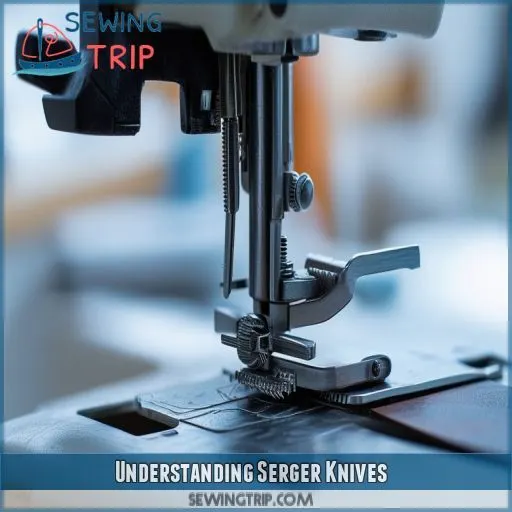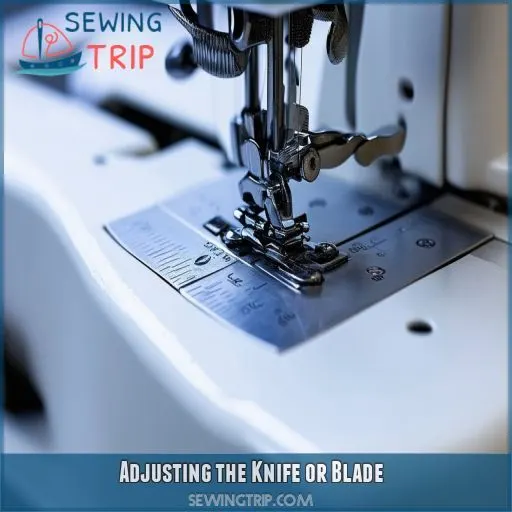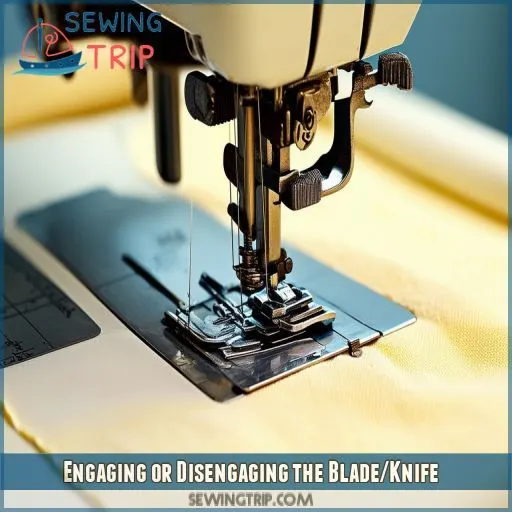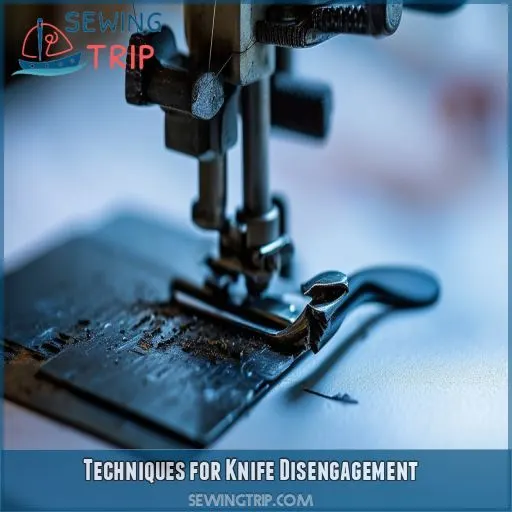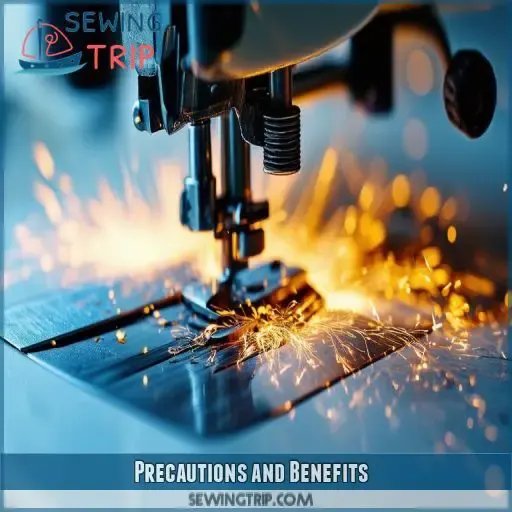This site is supported by our readers. We may earn a commission, at no cost to you, if you purchase through links.
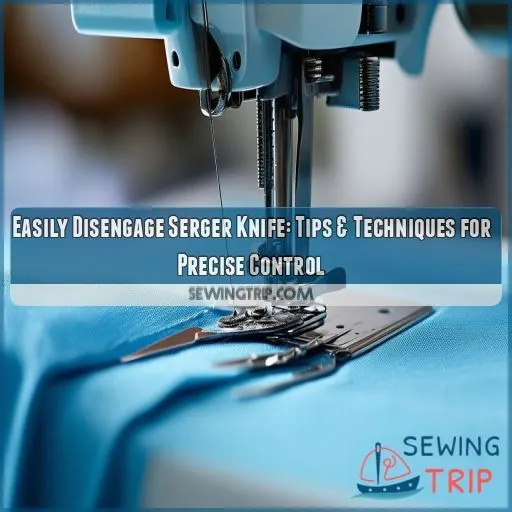
Unshackle yourself from seam limitations; disengage that blade with confidence. This guide equips you to harness your serger’s full potential, empowering innovative techniques while preventing fabric damage.
Embrace the freedom disengagement offers; elevate your serging prowess today.
Table Of Contents
Key Takeaways
- Disengaging the knife on a serger allows for different stitching techniques, such as rolled hems and decorative stitches, without cutting the fabric.
- Knife disengagement is necessary when changing from a regular serge stitch to a rolled stitch or when experimenting with different stitch widths.
- To disengage the knife, locate the lever or knob on the side of the serger and move it to the opposite direction, which will keep the knife from going up and down and cutting.
- Regular lubrication, knife angle adjustment, and knife replacement are important precautions to maintain the serger’s performance and ensure optimal cut quality.
How to Disengage Serger Knife ?
To disengage a serger knife, locate the lever or knob on your serger that controls the knife’s movement and adjust it to stop the knife from cutting the fabric. This process varies by model but generally involves either lowering the knife or moving it out of the way for non-cutting tasks.
Understanding Serger Knives
Understanding Serger Knives is crucial for precise sewing control. The function of cutting blades and the roles of upper and lower knives are key aspects to master.
Function of Cutting Blades
When you’re wielding a serger, think of the cutting blades as your fabric’s personal stylist, snipping away excess with precision.
Mastering the art of blade adjustment means you can switch from construction to decoration in a flash.
Disengage that blade, and voila, you’re crafting decorative stitches like the flatlock stitch without a single snip—your serger’s versatility at your command.
Upper and Lower Knives/Blades
To master serger knives, you must understand their upper and lower positions.
The upper knife, an upside-down hook in front of needles, moves up and down.
The lower knife, stationary under the needle plate, is essential for serging stitches and maintaining fabric edges.
Knife positioning and blade adjustment are crucial for decorative stitching, knife disengagement techniques, and knife maintenance.
It’s not merely about cutting fabric; it’s about enhancing the benefits of serging.
Adjusting the Knife or Blade
Most sergers come equipped with an adjustment dial that you can turn to fine-tune the blade’s distance. Always run a few test strips after making adjustments to ensure the fabric’s edge looks just right.
Most Sergers Have an Adjustment Dial
Adjusting your serger’s knife is like finding the sweet spot in a game of darts—precision is key. Most sergers come equipped with adjustment options, accessible through a dial or knob. Before you dive in, grab some test fabric choices to ensure you’ve nailed the adjustment. Here’s a quick guide:
| Adjustment Options | Dial Variations | Test Fabric Choices |
|---|---|---|
| Knob Placement | Needle Positioning | Directional Fabrics |
| Engage Blade | Disengage Knife | Natural Dye |
Running Test Strips After Adjusting
After adjusting your serger’s blade, it’s time to put it to the test. Run some test strips on scrap fabric to ensure the stitch quality is just right. Visually inspect the stitches and make any necessary tension adjustments. This step is crucial for achieving the perfect finish every time. Don’t skip it!
- Evaluate blade movement and stitch quality
- Adjust tension as needed based on visual inspection
- Repeat test strips until you achieve the desired results
- Trust your eyes – they’re the best tool for the job!
Engaging or Disengaging the Blade/Knife
Knowing when to engage or disengage your serger’s knife can significantly impact your sewing project’s outcome. It’s a skill that allows for both the creation of clean edges and the exploration of decorative stitching techniques.
When to Disengage the Knife
When to Disengage the Knife
Knife disengagement is a feature that can be used in various ways to enhance your sewing experience, especially when working with different types of fabrics and stitch effects. Here are some scenarios where you might want to disengage the knife:
1. Decorative Sewing:
When you want to create decorative stitches like flat lock stitch, you can disengage the knife to avoid cutting off fabric. This technique is particularly useful when working with elastic to prevent nicking.
2. Fabric Experimentation:
If you’re working with specific fabrics such as string sequin mesh, you may need to disengage the knife to prevent curling or to achieve a unique decorative effect.
3. Stitching Without Cutting:
Disengaging the knife allows you to stitch without cutting the fabric, which can be beneficial when you want to maintain the integrity of the fabric edge.
4. Roll-Hemming:
For certain fabrics, you may need to disengage the knife to create a rolled hem. This technique involves folding the fabric over and stitching at the edge without the upper blade, then pulling the fabric taut to create a ladder stitch on one side and a regular serger stitch on the other.
5. Adjusting Stitch Width:
When adjusting the stitch width on your serger, you may need to disengage the knife to achieve the desired stitch width. This can be useful when working with very thick or thin fabrics, or when you need to remove the stitch finger for narrower stitches.
6. Changing Stitch Length:
If you want to control how much a fabric gathers or adjust the appearance of your stitches, you may need to disengage the knife to change the stitch length.
7. Creating Ease:
When you need to ease two pieces of fabric together, disengaging the knife can help you achieve the desired effect.
Benefits of Engaging/Disengaging
Engaging or disengaging your serger’s knife isn’t just about cutting fabric; it’s about stitch control and the freedom to create. Here’s why you’ll love playing with this feature:
- Benefits: Precision in every stitch, whether trimming or not.
- Drawbacks: Keep an eye on knife alignment; it can shift over time.
- Disengaging Over Time: Allows for diverse decorative techniques without snips.
- Stitch Control: Master your edges, master your craft.
Techniques for Knife Disengagement
To disengage the serger knife, you can try pushing the blade to the right while rotating it. This technique may help you move the knife out of the way on your Juki 644-MO-D serger. Additionally, you can disengage the knife for decorative stitching, such as flat lock stitch, which allows you to stitch at the edge without cutting the fabric.
Flat Lock Stitch
Switching gears from blade engagement, let’s dive into the flatlock stitch—a real game-changer. Imagine stitching without slicing your fabric; that’s the magic of disengaging your serger’s knife. You’ll create rolled hems that are nothing short of decorative masterpieces. Plus, you can stitch without curling, making every seam as smooth as a buttered-up banister. It’s serging sorcery at its finest!
Other Uses for Knife Disengagement
When it comes to serger knife disengagement, the possibilities go beyond the basics.
Roll hemming delicate fabrics like string sequin mesh, creating unique decorative effects, and stitching without cutting fabric are just the beginning.
This technique not only prevents nicking but also unlocks a realm of creative stitching options.
Experiment with different fabrics and stitches to unveil the secrets of decorative stitching without the fear of cutting off your fabric.
Precautions and Benefits
To ensure your serging projects remain flawless, understanding the benefits of disengaging your serger knife is crucial. By mastering this technique, you can avoid fabric damage and unlock a world of decorative stitching possibilities.
Avoiding Fabric Damage
Transitioning from knife disengagement techniques, let’s dive into avoiding fabric damage. It’s like walking a tightrope; precision is key. Here’s how:
- Regularly lubricate your serger knife to ensure smooth sailing.
- Adjust the knife angle for the perfect cut.
- Keep track of knife replacement intervals; don’t push your luck.
- Master knife sharpening techniques for a keen edge.
- Always adhere to knife safety precautions to avoid any oops moments.
Decorative Stitching Possibilities
Disengaging the serger knife opens up a world of decorative stitching possibilities.
You can try roll-hemming on fabrics like string sequin mesh, which can be challenging with a regular serger.
This technique allows for stitching without cutting the fabric, creating unique decorative effects.
Experiment with different fabrics and stitches to find what works best for your project.
Don’t forget to adjust the blade distance for optimal results.
Frequently Asked Questions (FAQs)
How often should serger knives be replaced?
You’ll want to replace serger knives after 5-8 projects or once they start shredding fabric edges instead of cutting cleanly. Sharp blades give professional results, so replace them regularly for optimal performance.
Can disengaged knives affect serger tension settings?
Don’t worry, disengaging those pesky serger knives won’t throw your tensions out of whack. It’s an independent operation – like a get out of jail free card for your fabric!
Are all serger knives universally compatible?
No, serger knives aren’t universally compatible. You’ll need the specific knife for your serger model from the manufacturer. Don’t cheap out – a quality knife ensures precision stitching and fabric cutting.
How to clean serger knives without disengaging?
Clean serger knives without disengaging? No problem! With a small brush and some sewing machine oil, gently clean the blades while exercising care around the sharp edges. Routine cleaning prevents fabric buildup, ensuring precise cuts.
Does knife disengagement impact stitch quality?
You’ll be sewing like a pro, my friend – disengaging that serger knife won’t impact stitch quality one bit. It’s all about giving you more creative control, just like a painter adding depth and texture to their canvas.
Conclusion
Wielding the power to disengage your serger knife unlocks a realm of creative possibilities. Like a master sculptor chiseling away at stone, you’ll command precision and control, shaping fabric into intricate designs. Embrace this technique to prevent damage while exploring flat lock stitches and decorative embellishments. Unleash your serger’s full potential by mastering how to disengage serger knife with confidence.

